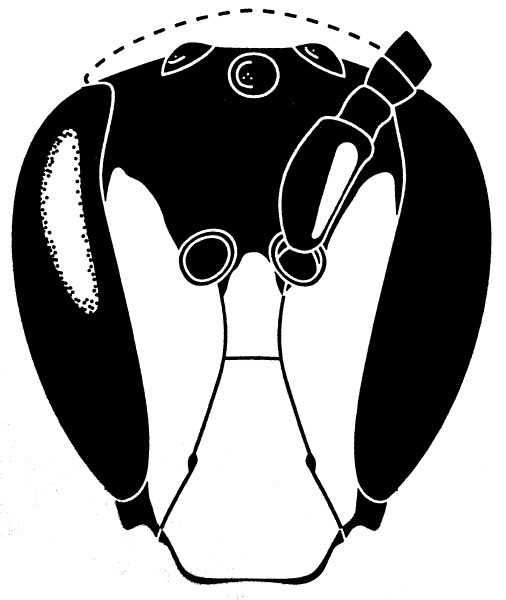Hylaeus in Hawaii

Hylaeus in Hawaii |

|
Hylaeus longicepsIslands: Oahu, Molokai, Lanai, MauiLocations: Oahu - (Kaena Point NAR, Kahuku) Molokai - (Moomomi) Lanai - (Kahue, Polihua Rd., Shipwreck Beach) Maui - (Waiehu Dune) Habitats: Coast and dry lowlands Plants: Chamaesyce, Ipomoea, Myoporum, Santalum, Scaevola, Sesbania, Sida, Tournefortia, Vitex Xerces: Hylaeus longiceps is a coastal bee endemic to the islands of Oahu, Molokai, Lanai, and Maui in Hawaii. It is distinguished by its long head and large facial marks. It can be found relatively abundantly where it exists, but habitat destruction has caused its range to contract significantly. Hylaeus longiceps is restricted to small, widely scattered sites, and populations are vulnerable to extinction. Species Profile 
Insects of Hawaii: Medium-sized bees with clear to slightly smoky wings. Male lower face entirely yellow, extended at sides in a broad stripe above antennal sockets, unusual supraclypeal area very long and narrow, scape weakly dilated (H. solaris from Kauai has a similar long supraclypeal area, but the scape is dilated). Female black and unmarked. The supraclypeal area is variable in shape, but consistently longer than wide (8 bees, W/L ratios 0.6-0.8), and the face is unusually long and narrow overall. Only H. solaris has a similarly narrow face; while it also has similar facial markings, the two species are not closely related. Insects of Hawaii Volume 17 
UH/DOD: Found on both Oahu and the islands of Maui Nui, this species is extremely rare on Maui but was found in moderate numbers on Lanai and Molokai during 1999-2002, and formerly had a significant population at Kaena Point (Daly and Magnacca 2003). However, like H. anthracinus there, it has almost completely disappeared in the last few years. Over the course of multiple visits to Kaena, only two individuals were observed (both males), despite good flowering of the plants, favorable weather, and few alien bees. This had been the only known population on Oahu, but late in this survey a second one was discovered at Kahuku Point (Figure 9). Although small in area, they occur at relatively high density on Sesbania and Heliotropium there. This area is potentially threatened by development - it is directly makai of the Turtle Bay Resort golf course, and although earmarked as park land in the Turtle Bay expansion draft supplemental EIS (Sichter 2012), impacts on native invertebrates were not considered, nor were the Sesbania noted in botanical surveys for the DSEIS. Hylaeus near military lands 
Other: |

|